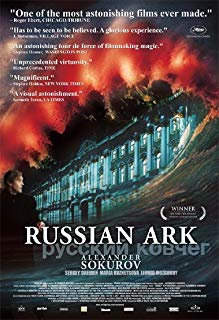俄罗斯方舟/创世纪/
導演: 亞歷山大蘇古諾夫編劇: Boris Khaimsky Anatoli Nikiforov
演員: Sergei Dontsov 柯里亞史比里道諾夫 Leonid Mozgovoy Mikhail Piotrovsky

2012-04-21 16:43:12
"A Very High Price": Sacrifice in Russian Ark
************這篇影評可能有雷************
Russian Ark uses the motif of sacrifice as a method to engage with history and old media both directly and indirectly. The two scenes that I felt best reflected this use of the motif were, respectively, the engagement with the war room and the brief depiction of a classical Abraham and Isaac painting.
The vague anxiety that permeates the beginning of the war room scene functions not only to provide us with hints to the contents of the room before they are revealed-- much in the same manner that other scenes in the film encourage us to guess which event or person is being alluded to prior to the reveal-- but also functions to situate us in a context, not of military strategy or political justification, but of bodily sacrifice. The presence of the coffins in the room and the traumatized, debased coffin builder emblematic of loss of national morale encourages us to understand the war not within its distinct context, but within the universal context of the body count and its significances to the human community. After he exits the room and is told by the narrator that one million Russians died in the war with Germany, the stranger repeats to himself, 「A very high price.」 The corpses alluded to are recognized as exchanged capital, and are understood in relation to one another, defined ultimately by the total number that they come to rather than by each life that composes the whole. A price is something intentionally and consciously paid, and in this sense it holds a strong connection to the notion of sacrifice. The sacrifice holds meaning only when it is made consciously. The sacrifice, like the price, may not reap the benefits desired, and both the sacrifice and the price may be very or too high.
Later in the film, Rembrandt’s Abraham and Isaac depicts the title biblical narrative. As is the case in most of the paintings shown, a glare appears and the intersection of the camera between the viewer and the painting reminds us that we are engaging with the art, not as it was meant to be engaged with, but through the literal and metaphoric lens of modernity. Furthermore, the angle from which the camera approaches the painting emphasizes Isaac’s body to a greater extent than the painting itself might when viewed directly. This engagement with the painting and the narrative presented increases the film’s anxieties surrounding and ultimate rejection of the apparent nobility of sacrifice. Isaac’s body, pale as a corpse, faceless and without identity because of his father’s clamping hand, and arching ineffectively against his own victimization and near-murder, stands in for the corpses the audience was never shown in the war room. The angel seems to arrive just in time, but when we are confronted with Isaac’s body, we are asked whether or not this is true. Isaac’s death can be prevented, but the conditions for his own father’s willing sacrifice of him are already a central facet of the world of the painting and the world of the film.
------------------------------------
Other Thoughts about Russian Ark
Russian Ark is one of the most elegant film I have ever watched. For me, the watching experience is like listening to a Russian ballad that structures with prelude, variations and finale. Each door in the museum/film is a beginning of a new movement, and within the movement, there are performances. The characters in the film are all actors. As they are performing, they reproduce the history in a really exquisite and theatrical way. Some people talk about how they feel exhausted when watching the film because of the rich hidden history and mystery of Russian and Russian Arts and the ninety minutes long take. However I found it did not bother me at all, and the lack of knowledge of Russian history did not disturb me with perceiving this beautiful piece either. I particularly enjoyed the use of long take. From the beginning to the end, the camera swings from one scene to another, and the way camera moves as if it is dancing in the air. It creates such a strange but melodic ghost feeling that 「I」, the first person in the film (as well as from the spectator’s perspective), am so out of place but at the same time so close to the characters whom I encountered through the journey. This feeling reminds me so much of Bertolt Brecht’s ideas of 「alienation」 that prevents the audience from losing itself passively and completely in the character by the actor, and which consequently leads the audience to be a rational consciously critical observer. The distance and the obscure morphosis of time and space in the film construct an unique historical fantasy that link Russian history and art closely together. The uniqueness also ties to Russian culture itself that embeds a double identities of both Europe and Asia. Though the finale ends into the deep surrounding sea, I see history continue flowing by, silently, just like the flowing water in the end because "we are destined to sail forever, to live forever."

